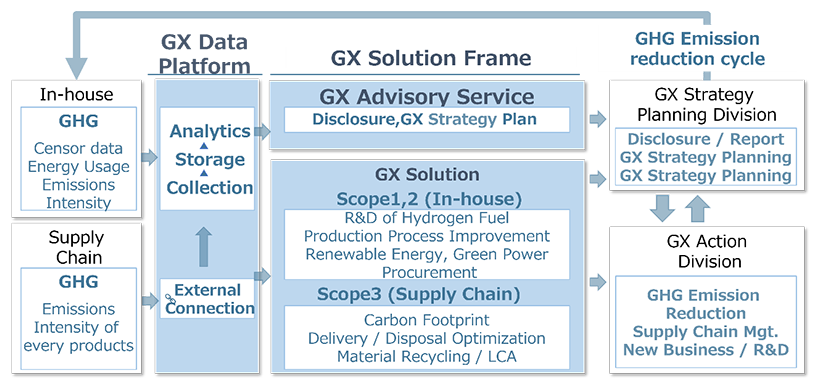Aug 31, 2022 ITOCHU Techno-Solutions Corporation
ITOCHU Techno-Solutions Corporation (headquartered in Minato-ku, Tokyo; Ichiro Tsuge, President and CEO; hereinafter “CTC”) has systematized its carbon neutrality-related services to offer them as a menu of green transformation (GX) services. The services include support for the visualization and reduction of corporate greenhouse gas (GHG) emissions, the introduction and utilization of renewable energy, and the construction of data utilization infrastructure for these purposes. Based on its simulation technologies accumulated over many years, such as technologies for forecasting the output of wind and solar power generation equipment, CTC provides the services to companies and other organizations to contribute to GX to establish a carbon neutral economy and society.
The efforts to achieve carbon neutrality by 2050 and GHG emission reduction targets by 2030 should be regarded as opportunities to achieve sustainable growth. Initiatives should be taken to transform the entire economic and social system to achieve this. This combination of efforts and initiatives is called GX and companies must promote GX measures to address global warming and climate change issues.
CTC has long been providing consulting and system development services to renewable energy power generation companies based on its technologies for weather data analysis and simulation that it launched around 1990. We have systematized the solutions and services that were previously provided individually to support each company's promotion of GX. This service system consists of the GX Solution Frame for GHG reduction, and the GX Data Platform for data handling.
The GX Solution Frame brings together various solutions for the reduction of GHG emissions under the categories of GX Solutions, which provide technical assistance to companies to reduce their GHG emissions and improve the efficiency of their energy use, and GX Advisory Services, which support the formulation of GX strategies, including information disclosure and GHG reduction strategies.
As GX Solutions, technical assistance for the reduction of GHG emissions is provided by combining simulation, AI-powered digital twins, system infrastructure and other technologies. The combination of technologies is tailored to the characteristics of each business and the scope of calculation based on the GHG Protocol, a set of standards for calculating and reporting supply chain GHG emissions (Scope 1, 2, and 3).*1 GX Advisory Services support customers' environmentally sound business management based on collected data by providing services including the preparation of information disclosure materials and GHG emissions reduction scenarios, the formulation of GX strategies, assistance for the trading of environmental value, and proposal for use of renewable energy.*2
GX Data Platform services are provided to establish a data utilization platform that facilitates collaboration between corporate planning departments and business and front-line departments at each company to reduce GHG emissions. Currently, the collection and management of the GHG emissions data of a company and its supply chain is a challenge due to the many manual processes involved. In addition to supporting the collection and management of GHG emissions data, our services enable data visualization and AI-powered analysis.
CTC will continue to expand its menu of GX-related services based on “Contribute to climate change countermeasures,” one of its material topics, and contribute to the realization of carbon neutrality for its customers and our society.
CTC's GX Service System

Details of GX Service
For more detailed information, please visit the following:
https://www.ctc-g.co.jp/company/release/doc/20220831a_gx.pdf(PDF/519KB)
- *1GHG Protocol: A global standard for calculating and reporting supply chain GHG emissions. It divides an organization's emissions into three scopes according to the organizations’ supply chain and defines supply chain emissions as the sum of the emissions within each scope. Below is an explanation of each scope (from the Ministry of the Environment's website).
Scope 1: Direct GHG emissions by the businesses themselves (fuel combustion, industrial processes).
Scope 2: Indirect GHG emissions from the use of electricity, heat, and steam supplied by other companies.
Scope 3: Indirect GHG emissions other than Scope 1 and Scope 2 (emissions by others related to the company’s business activities). - *2Environmental value: The added value of renewable energy that does not emit CO2,
which can be traded in the form of certificates. - *3Carbon footprint (the carbon footprint of products): A system for converting the GHG emissions throughout the entire lifecycle of products and services, from the procurement of raw materials to disposal and recycling, into a CO2 emissions figure and displaying them on the packages of products and services.
Contact Information
ITOCHU Techno-Solutions Corporation, Corporate Communications Dept.
E-mail:press@ctc-g.co.jp
Currently displayed information is correct at the time of the announcement. Please be aware that information displayed may differ from the very latest information.
